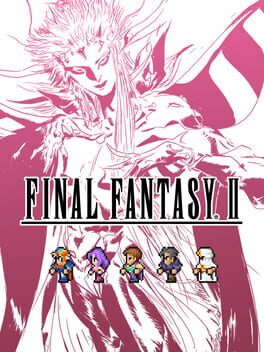This review contains spoilers
I’d played the PSP remake of FFI before, but on my few attempts at starting the accompanying version of the second game I somehow got lost as early as the first time stepping into the world map. Resulting from this, Final Fantasy II, III, IV and V have always been an obvious gap in my experience with the franchise. I’ve played just about everything that comes after them, yet the franchise’s classic era felt like a locked chest. I’d picked up little bits and pieces from Dissidia, which would only further emphasize their sense of mystery and intrigue. Part of me does feel a slight tinge of regret that I didn’t simply get around to them earlier in their original forms, but I think that the Pixel Remaster is a project that I really needed to finally find motivation to tackle them. The amount of progress this game made as a sequel is insane. While the Warriors of Light certainly were present, their complete and utter lack of agency in the narrative makes Garland the central character in Final Fantasy I. Functionally-speaking, FFII’s Firion then becomes Final Fantasy’s first proper protagonist. His personality is ultimately pretty basic too from not having much dialogue, but when viewed in the context of “FF’s original character” he becomes a bit of a spectacle. The franchise and fanbase have forgotten him, despite actually holding such immense prestige.
Ultimately I do still find myself preferring the more experimental settings introduced after FFVII’s revolution, compared to the homogenized high fantasy of the retro FF titles. But nevertheless, FFII’s medieval setting displays a high level of potency due to The Emperor’s effectiveness as a villain. The story is surprisingly brutal. Mateus repeatedly succeeds in massacring the rebels. After the first game’s relatively painless story about the princess and an evil knight, I didn’t expect Final Fantasy II to immediately leap into such widespread war and death. After only a single attempt the narrative managed to strengthen itself so dramatically. The gameplay is considered the entry barrier of the second Final Fantasy, and I do recall having being put off by it beforehand myself. By the time of the Pixel Remaster however, I found myself well-versed enough in JRPGs that the levelling system wouldn’t make me so much as bat an eye. The encounter rate is tediously high, but really, when isn’t it? I’m not sure I’ve ever played a JRPG that left me satisfied with its random encounters. Having to backtrack to Altair after seemingly every plot point is pretty torturous, but other than that the game design evolves by leaps and bounds. Environmental design is much more dynamic than the prior game. Musically there weren’t standouts like Chaos Shrine and Castle Corneria, but on the whole the soundtrack felt more balanced. Where Final Fantasy was a bunch of ideas slapped together, Final Fantasy II then focuses on making all its elements work synergistically. To simply be a better video game. All up, assuming that the Pixel Remasters are at least somewhat of a faithful indicator of the original releases, this game is a phenomenal sequel. To the extent that it exposes the first game as feeling like a tech demo.
Ultimately I do still find myself preferring the more experimental settings introduced after FFVII’s revolution, compared to the homogenized high fantasy of the retro FF titles. But nevertheless, FFII’s medieval setting displays a high level of potency due to The Emperor’s effectiveness as a villain. The story is surprisingly brutal. Mateus repeatedly succeeds in massacring the rebels. After the first game’s relatively painless story about the princess and an evil knight, I didn’t expect Final Fantasy II to immediately leap into such widespread war and death. After only a single attempt the narrative managed to strengthen itself so dramatically. The gameplay is considered the entry barrier of the second Final Fantasy, and I do recall having being put off by it beforehand myself. By the time of the Pixel Remaster however, I found myself well-versed enough in JRPGs that the levelling system wouldn’t make me so much as bat an eye. The encounter rate is tediously high, but really, when isn’t it? I’m not sure I’ve ever played a JRPG that left me satisfied with its random encounters. Having to backtrack to Altair after seemingly every plot point is pretty torturous, but other than that the game design evolves by leaps and bounds. Environmental design is much more dynamic than the prior game. Musically there weren’t standouts like Chaos Shrine and Castle Corneria, but on the whole the soundtrack felt more balanced. Where Final Fantasy was a bunch of ideas slapped together, Final Fantasy II then focuses on making all its elements work synergistically. To simply be a better video game. All up, assuming that the Pixel Remasters are at least somewhat of a faithful indicator of the original releases, this game is a phenomenal sequel. To the extent that it exposes the first game as feeling like a tech demo.
